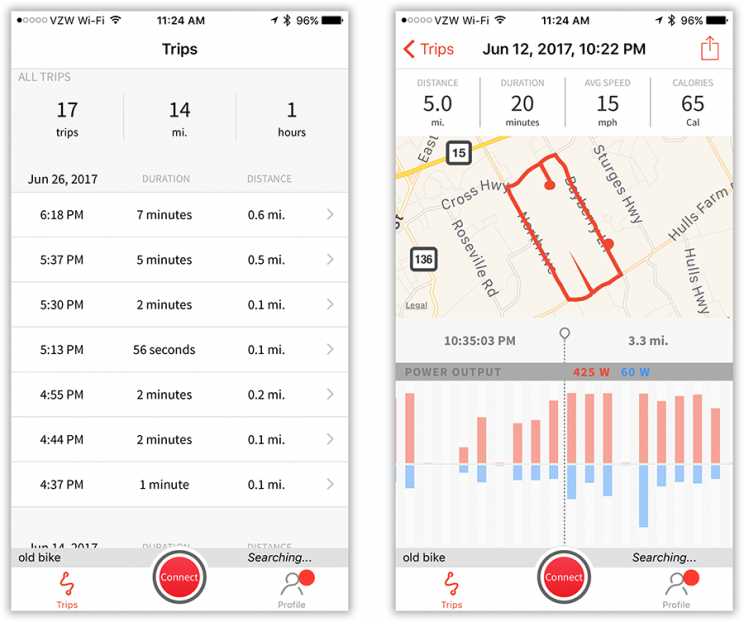Electrify your existing bike in 2 minutes with these ingenious wheels
You may not be European. So you may not know about electric bikes, which are white-hot popular in the cities of Europe.
On an e-bike, a smooth, silent motor boosts your pedaling, making easy work of hills and headwinds. E-bikes offer a perfect middle ground between cars (easy, but expensive to drive, expensive to park, and polluting) and regular bikes (free, non-polluting, but you get to work sweaty). An e-bike means never paying for gas, sailing past traffic jams, and never having to hunt for parking.
As long as an e-bike’s motor tops out at 20 miles per hour (15 in Europe), your government considers it a bicycle. So—unlike with motorcycles—you don’t need a license, you don’t have to be 16, you don’t have to register it, and don’t have to fuss with a bunch of laws.
That part was supposed to get you excited about e-bikes. Now here’s the part where you crash: Good e-bikes start at $3,500 and go way, way up. (Here’s my review of four of them.)
But suppose you could electrify the bike you already have? Suppose you could just pop off its wheel, and replace it with a motorized one. Then you could have an e-bike for a fraction of the price—without giving up the frame, seat, brakes, gears, and handlebars you already own and love.

That’s the idea behind the Copenhagen Wheel and the Geo Orbital wheel. (A third, really promising replacement wheel, called the UrbanX, was a successful Kickstarter project and then, renamed UrbaNext, succeeded on Indiegogo. Apparently they’re accepting pre-orders. But the company didn’t respond to a dozen emails I sent over a couple of weeks, they didn’t reply to any queries sent through their web form—and their phone number in Singapore is disconnected. I sure hope UrbanX isn’t Urban Ex.)
Both companies are based in Massachusetts, both wheels are waterproof and rechargeable, and both wheels change bike-riding game.
GeoOrbital
This futuristic, robotic-looking circle ($1,000) replaces your existing bike’s front wheel. As a result, you can perform the entire wheel-replacement surgery in, no joke, two minutes after viewing the installation video. Spread your brake pads, open the quick-release clamp, swap wheels, redo the clamp and brakes, and then snap the thumb throttle onto your handlebar. You can’t use the GeoOrbital on bikes with disc brakes.

On the other hand, a front-wheel design has no way to know how hard you’re pedaling, or even if you’re pedaling. You don’t get any help from your e-wheel except when you’re holding down the thumb throttle. (Throttle-powered e-bikes are illegal in the bike lanes of Europe, however.)

There’s a long list of juicy features. The tire is made of hard foam, so it can’t ever go flat. The ignition key locks the removable battery in place, and also turns the power on or off.

You can get the GeoOrbital in either of two sizes. The smaller one, for 26-inch bikes, has a smaller battery, and therefore a lower weight (17 pounds), charging time (3 hours), and range (12 miles without pedaling, or 30 miles with pedaling).
The larger one (for bikes with 28, 29, and 700c wheels) is more massive: 21 pounds, 20-mile range without pedaling (50 miles with pedaling), recharges in 4 hours. Of course, you should take all e-bike range estimates with a grain of salt the size of your fist. Your weight, speed, and terrain all have a huge effect on those numbers.
You’re not going to fool anyone with the GeoOrbital’s looks: It’s truly weird-looking and attention-getting, like it’s made from the Terminator’s spare parts. The hub’s three giant arms press against the wheel rim—the tire rotates, but the contraption itself does not. (The company notes that this hubless design is a relative of the Lightcycles in the old Disney movie “Tron.”)
The motor makes a soft whine while it’s helping you, but it’s otherwise clean and quiet. Here’s what it looks and sounds like while you’re riding:
(Yes, I know it’s a decrepit, rusted bike—it’s the only 26-incher I had on hand.)
The GeoOrbital also boasts regenerative braking: When you’re coasting or braking, your momentum recharges the battery a bit. Unfortunately, when you’re not using power—when you’re just pedaling your bike as usual—the wheel fights you, adding resistance.
That, and the substantial front-weighting of your bike, make an unwieldy combination. A few of my test riders, initially delighted by the quiet whooshing feeling of GeoOrbital-assisted riding, lost a lot of their enthusiasm as a result.
The Copenhagen Wheel
This wheel costs more—$1,500—and replaces your back wheel. Installation is therefore a more complex operation than popping off the front wheel. You have to fiddle with your bike chain, for example. Takes about 10 minutes instead of one.

You can order this wheel for almost any bike—road, hybrid, or mountain; any kind of tire, in 700c or 26-inch sizes; single-speed or 7-, 8-, 9-, or 10-speed. You can also, by the way, order a beautiful complete bike with the Wheel already installed, for $2,000.

But wow, what a beautiful, compact, simple-looking machine. There’s nothing on your handlebar, no cable snaking up your bike frame. Instead, the shiny red capsule hub of your wheel contains everything: motor, battery, three computers, radio, and 74 sensors. If the design concept of the GeoOrbital is “all the technology is on display,” the Copenhagen Wheel’s is “conceal all of it.”

Of course, this design means that you can’t swap in a new battery; you’re stuck with one 30-mile charge at a time. It, too, recharges a bit when you brake or coast.
The center of the red capsule contains an on/off switch and a tiny door that protects the charging prongs.

When you start to pedal, the Wheel amplifies the power of your foot. This is the best part by far: The boost is smooth, silent, and controlled. The feeling is exhilarating. Everyone who tries it utters one delighted exclamation or another: “WOOHOO!!” or “Whoa!” or “Oh, wow!” or “Omigod!”
They get it immediately: That this wheel levels not only the hills of your city, but also the playing field for older, younger, or weaker riders.
UPDATE: The Copenhagen Wheel’s 20-mph limit has just been raised to 25 mph in the US and Canada. You can really fly now. The same firmware update introduces assisted braking: When you backpedal, the wheel helps to slow you down—and recharges its battery simultaneously.
A phone app—a little buggy, unfortunately—controls how much boost you get: Turbo, Standard, Eco, None (it’s just a bike), and Exercise (extra resistance, which recharges the battery). The app also auto-tracks your rides, maintaining a map, distance, time, and calories burned for each session. As you drag your finger around the map of your route, a graph shows you how much of the work you performed, and how much help you got from the wheel.

The app can also “lock” the wheel. It still turns, but a thief won’t get any assistance from the Wheel.
The huge benefit of replacing your rear wheel is, of course, that the Wheel knows when you’re pedaling, and how hard. It gives you a boost proportional to the effort you’re expending. Somebody up at Superpedestrian (the manufacturer) spent a lot of time fine-tuning the torque ratios so that it would feel smooth and magical.
Coasting Home
These two products address the same problem, but their philosophies could not be more different. The Copenhagen Wheel supplies power only when you’re pedaling; your bike may be superpowered, but it’s still a bike. The GeoOrbital, on the other hand, basically turns your bike into a moped. You can, if you like, just sit there and cruise along without pedaling at all.
Which philosophy you prefer is, of course, a matter of your philosophy.
The Copenhagen Wheel’s sophistication, polish, fun, and unobtrusiveness made it the favorite of most of my test riders; they felt it was easily worth the $500 price premium. At 17 pounds, it, too, is heavy (batteries and gravity, man—am I right?). Then again, regular e-bikes weigh around 50 pounds. And having the weight in the back feels more stable than having it in front.
Both of these wheels, though, beautifully execute their mission: Turning the bike you already own into a superbike.
More from David Pogue:
The 4 people Steve Jobs handpicked to review the iPhone reflect 10 years later
Marty Cooper, inventor of the cellphone: The next step is implantables
Apple polishes up 23 features in Mac OS High Sierra
The 27 most interesting features in iOS11
The DJI Spark is the smallest, cheapest obstacle-avoiding drone yet
The new Samsung Galaxy does 27 things the iPhone doesn’t
The most important announcements from Google’s big developer’s conference
Google Home’s mastermind has no intention of losing to Amazon
Google exec explains how Google Assistant just got smarter
Amazon’s Alexa calling is like a Jetsons version of the home phone
David Pogue, tech columnist for Yahoo Finance, welcomes nontoxic comments in the comments section below. On the web, he’s davidpogue.com. On Twitter, he’s @pogue. On email, he’s poguester@yahoo.com. You can read all his articles here, or you can sign up to get his columns by email.


